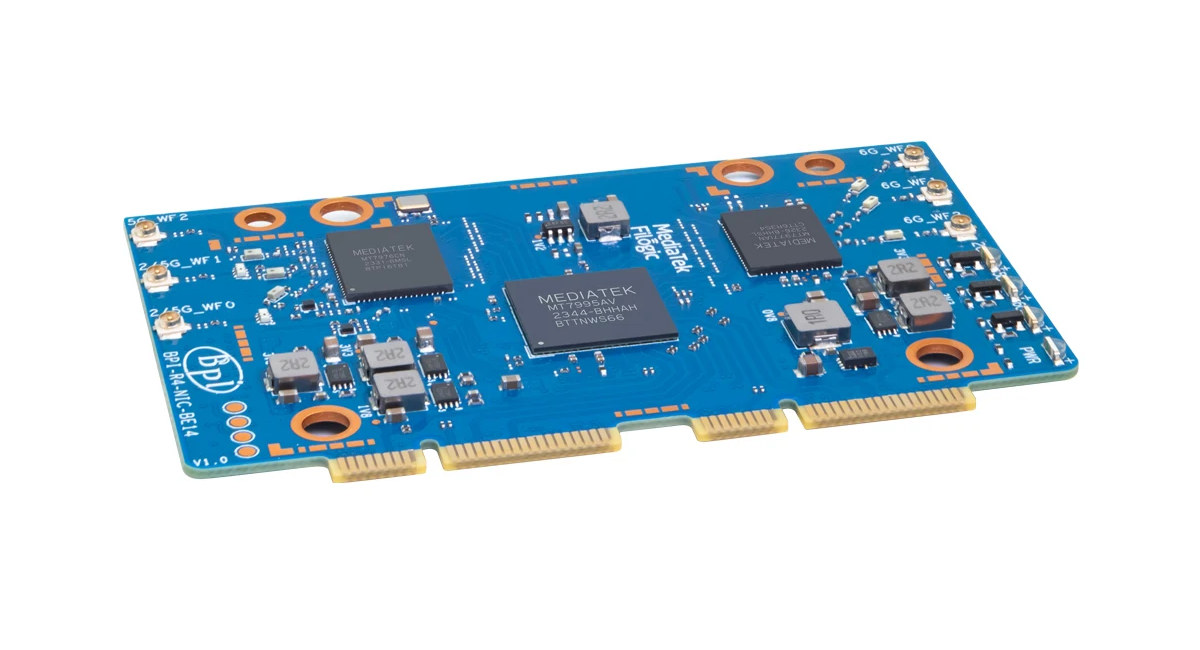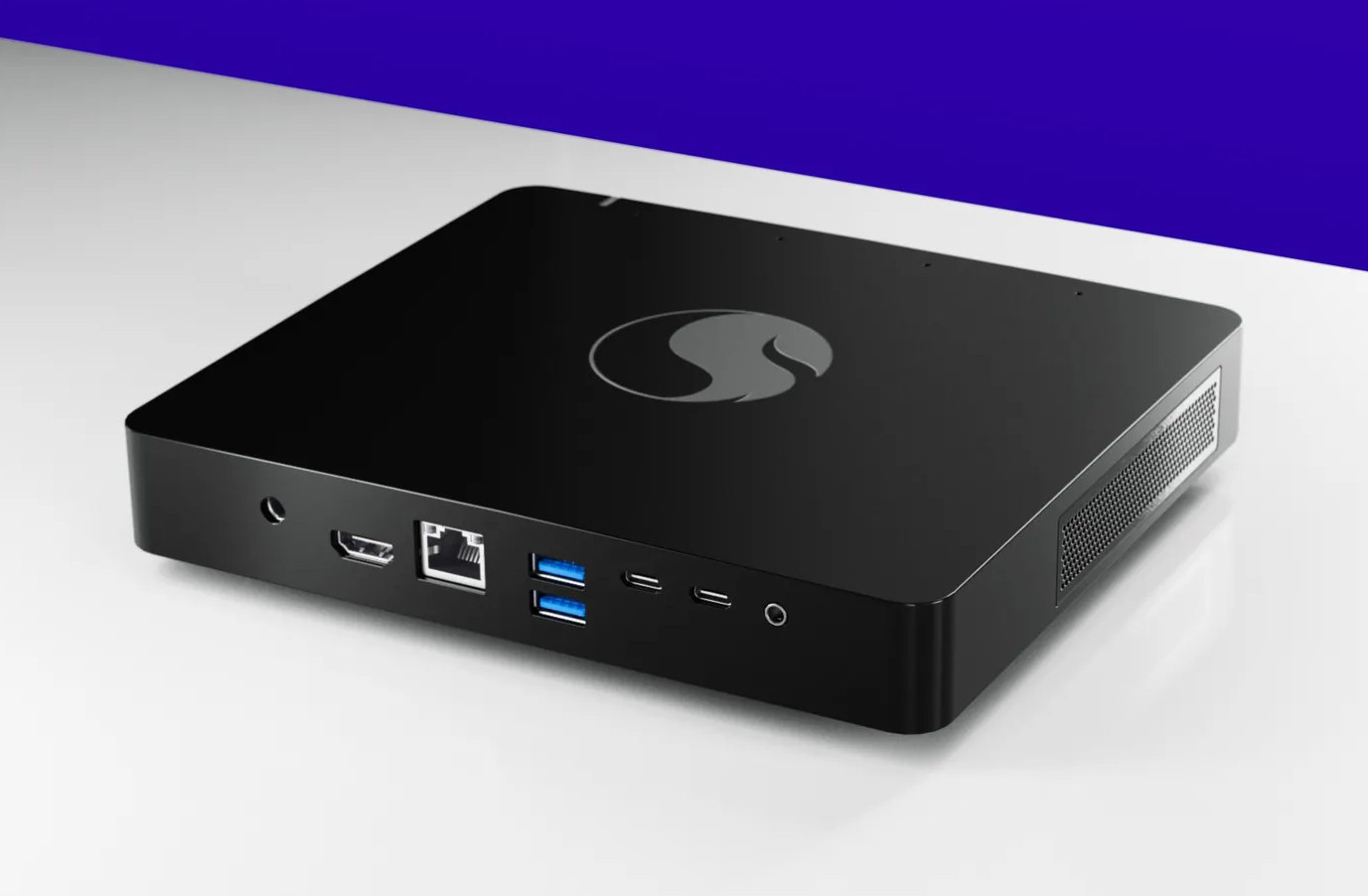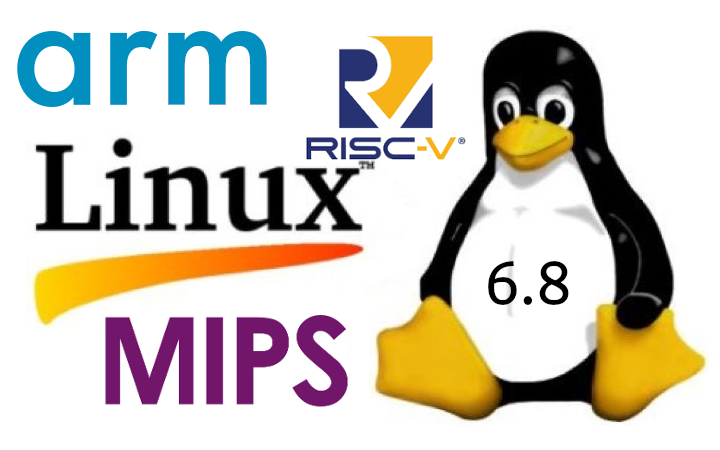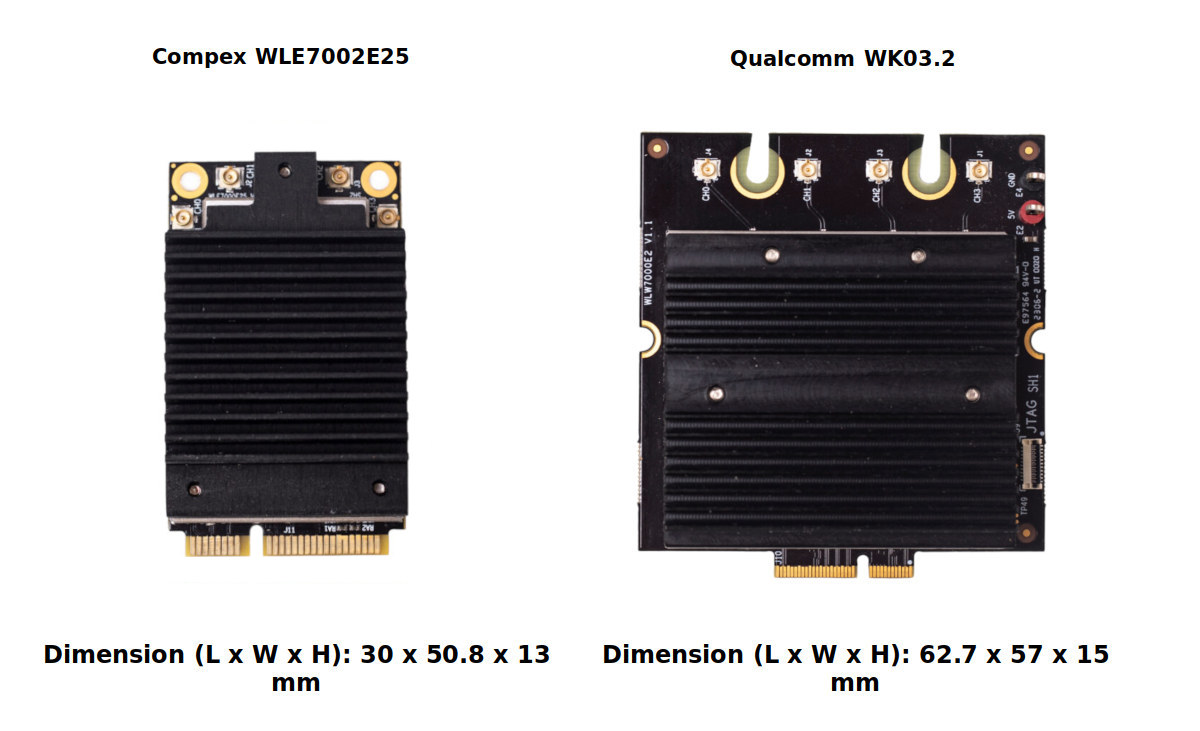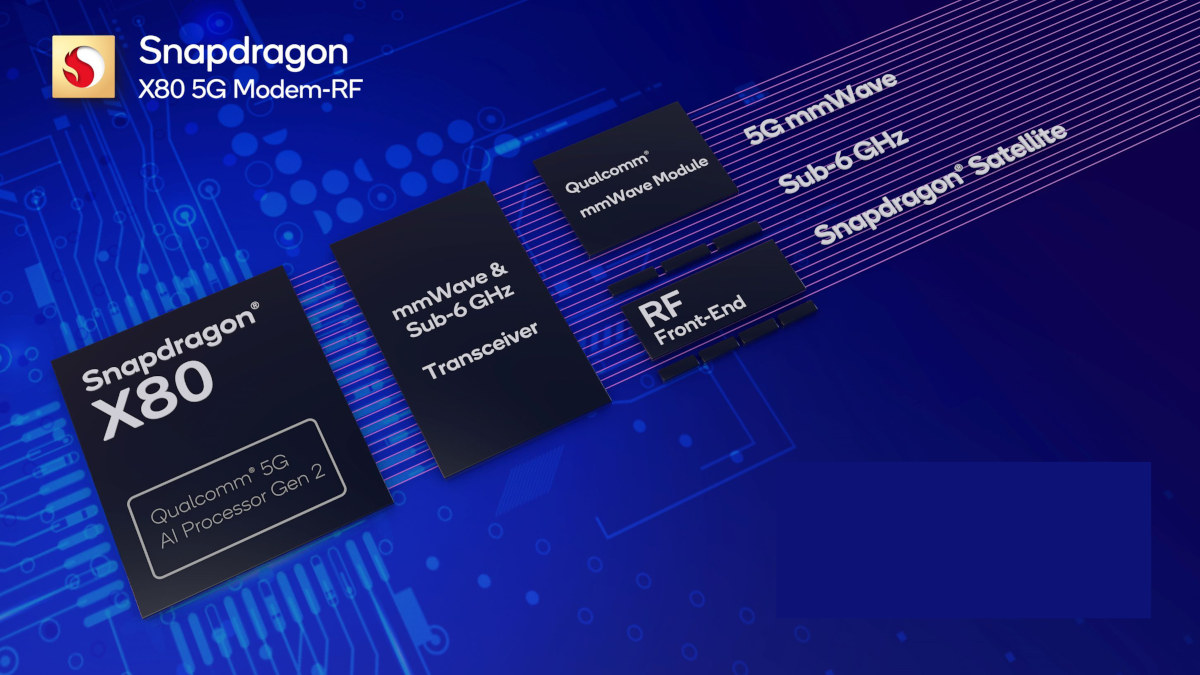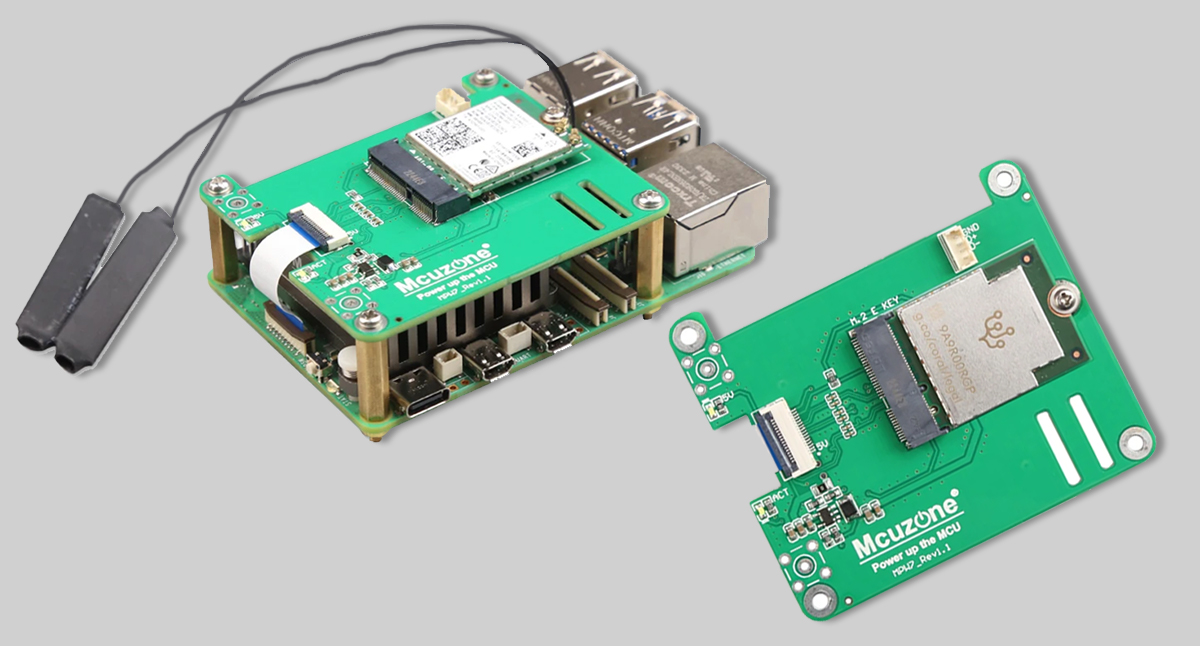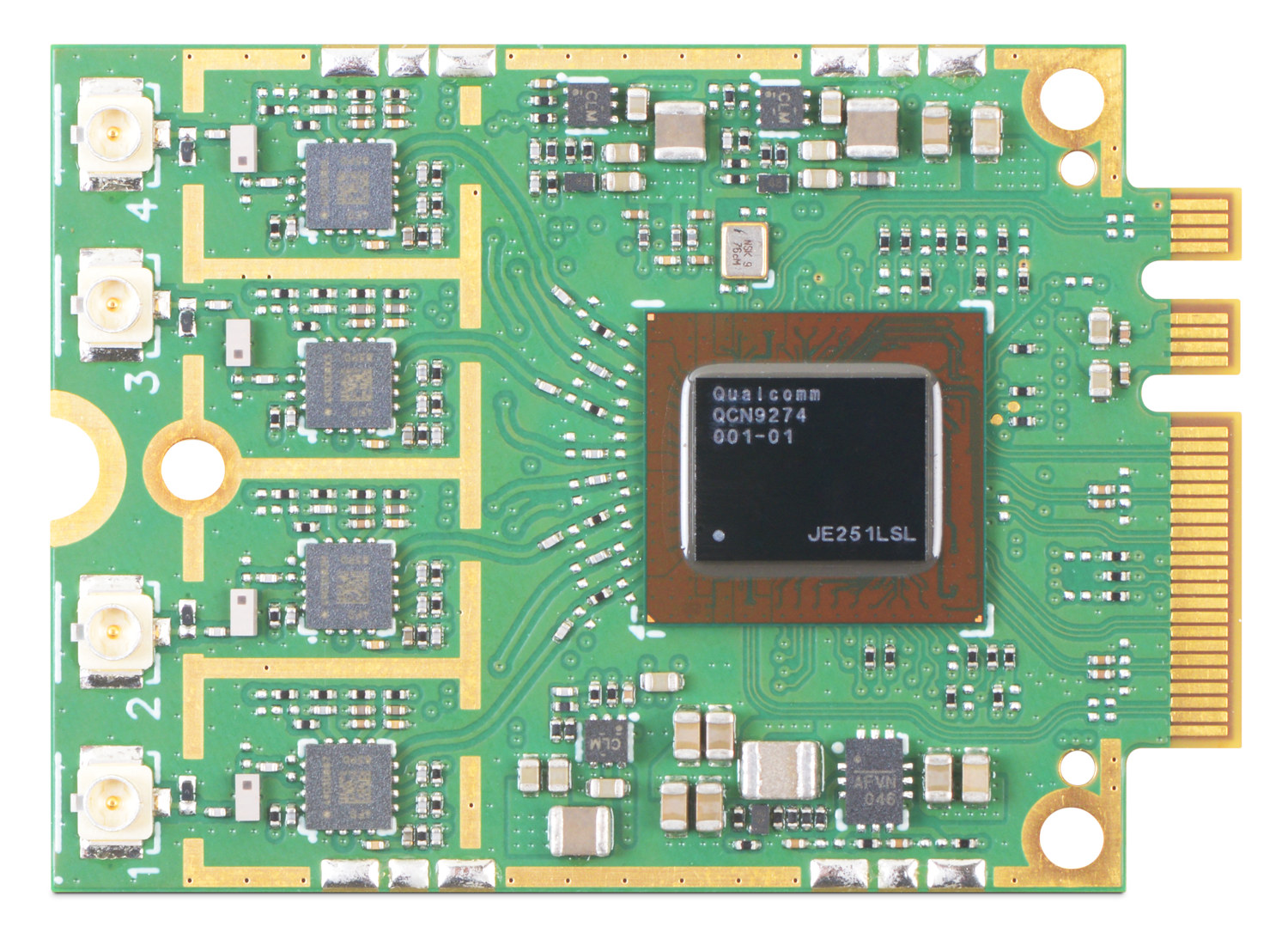The Banana Pi BPI-R4 was introduced last year as a WiFi 7 router board with two 10GbE SFP cages and four GbE ports based on MediaTek Filogic 880 SoC. The only issue is that WiFi 7 is implemented through a dual mini PCIe module that was not available until now. The good news is that the tri-band Banana Pi BPI-R4-NIC-BE14 WiFi 7 module for the Banana Pi BPI-R4 board can now be purchased for $73.69 on Aliexpress. It is based on MediaTek MT7995AV WiFi 7 chipset, MT7976CN dual-band (2.4GHz and 5 GHz) chipset, and MT7977IAN 6GHz chipset. Banana Pi BPI-R4-NIC-BE14 specifications: MediaTek MT7995AV WiFi 7 – IEEE 802.11 a/b/g/n/ac/ax/be compliant 32-bit RISC-V MCU for Wi-Fi protocols and Wi-Fi offload Embedded SRAM and ROM UART interface with hardware flow control MediaTek MT7976CN dual-band 2.4GHz 2×2 MIMO and 5GHz 3×3 MIMO MediaTek MT7977IAN 6GHz 3×3 MIMO Bandwidth 2.4 GHz – 20 and […]
Fibocom FG370 dual-band WiFi 7 and 5G cellular module targets 5G FWA routers
Fibocom FG370 is a compact module that combines WiFi 7 and 5G cellular connectivity designed for 5G FWA routers for the home, SMB (Small and Medium-sized Business), and industrial applications. Based on the MediaTek T830 quad-core Arm Cortex-A55 SoC, the FG370 supports 5G NR sub-6GHz, two 10Gbps USXGMII interfaces, and dual-band BE7200 WiFi 7 achieving an MLO (Multi-link operation) speed of up to 7.2Gbps. Note this is not the first “FG370 announcement” from the company, as global operators have used the 5G-only FG370 since October 2023, and the company introduced the FG370 with 5G and tri-band BE19000 WiFi 7 at MWC2024. The company has unveiled a mid-range variant of the FG370 module with 5G and BE7200 at Computex 2024. The company has yet to release a datasheet for the 5G + WiFi 7 variants, but for reference, here are the Fibocom FG370 (5G-only) specifications: (North American version) SoC – MediaTek […]
Snapdragon Dev Kit for Windows features Qualcomm Snapdragon X Elite Arm SoC for AI PC application development
Qualcomm Snapdragon Dev Kit for Windows is a mini PC-looking development platform based on the Snapdragon X Elite 12-core Arm processor with up to 75 AI TOPS of performance designed to help developers natively port apps to the Elite X SoC and develop new AI applications besides the Copilot+ AI PC features developed internally by Microsoft. Although it’s slightly bigger, the external design looks similar to the Windows Dev Kit 2023 with a Qualcomm Snapdragon 8cx Gen 3 compute platform, but internally, the new devkit features the much more powerful 4.3 GHz X Elite 12-core 64-bit Armv8 Oryon processor coupled with 32GB LPDDR5x RAM and 512GB NVMe SSD, and offering a range of ports and features such as USB4 and WiFi 7. Snapdragon Dev Kit for Windows (2024) specifications: SoC – Snapdragon X Elite (X1E-00-1DE) CPU – 12-core 64-bit Armv8 Oryon processor clocked at up to 3.8 GHz, or 4.3 […]
Linux 6.8 release – Notable changes, Arm, RISC-V, and MIPS architectures
Linus Torvalds has just announced the release of Linux 6.8 on the Linux kernel mailing list: So it took a bit longer for the commit counts to come down this release than I tend to prefer, but a lot of that seemed to be about various selftest updates (networking in particular) rather than any actual real sign of problems. And the last two weeks have been pretty quiet, so I feel there’s no real reason to delay 6.8. We always have some straggling work, and we’ll end up having some of it pushed to stable rather than hold up the new code. Nothing worrisome enough to keep the regular release schedule from happening. As usual, the shortlog below is just for the last week since rc7, the overall changes in 6.8 are obviously much much bigger. This is not the historically big release that 6.7 was – we seem to […]
Compex WLE7002E25 is a dual-band dual-concurrent WiFi 7 module in standard mini PCIe size (Sponsored)
In today’s hyper-connected world, reliable and high-speed wireless connectivity is no longer a luxury, but a necessity. WiFi standards have evolved rapidly. WiFi 6, which has been around for only a few years, is now being replaced by WiFi 7 or IEEE 802.11be. Equipment manufacturers are now rushing to phase in WiFi 7 products. Compex has released its latest WiFi 7 module WLE7002E25 to help shorten time to market. The Compex WLE7002E25 is a dual-band concurrent 2×2 2.4GHz and 2×2 5GHz radio based on Qualcomm’s Waikiki high-performance WiFi 7 chipset which is capable of over 10Gbps raw data rate. It is in a standard mini PCIe form factor. WiFi 7 in a Standard Mini PCIe Form Factor The standard mini PCIe footprint means that WLE7002E25 is readily compatible with existing systems and designs, particularly customers whose devices have been using WiFi 4 or WiFi 5 standard mini PCIe modules. This […]
Qualcomm unveils Snapdragon X80 5G modem with NB-NTN satellite connectivity, AI Hub, and FastConnect 7900 WiFi 7 chip
Mobile World Congress 2024 (MWC 2024) has just started, and Qualcomm had three major announcements with the introduction of the Snapdragon X80 5G modem with NB-NTN satellite connectivity, the Qualcomm AI Hub with over 75 AI models optimized for Snapdragon processors, and the FastConnect 7900 WiFi 7, Bluetooth, and Ultra Wideband (UWB) chip. Snapdragon X80 5G modem-RF system Snapdragon X80 5G modem specifications: Peak download speed – 10 Gbps Peak upload speed – 3.5 Gbps Cellular Modem-RF Specs – 10CC aggregation in mmWave, 5CC aggregation in 5G sub-6GHz Cellular Technology 5G NR, sub-6 GHz Dynamic Spectrum Sharing (DSS) LTE, WCDMA, LAA, TD-SCDMA, GSM/EDGE, CBRS mmWave, sub-6 carrier aggregation (FDD-FDD) sub-6 carrier aggregation (TDD-TDD), 5G FDD, 5G TDD, sub-6 carrier aggregation (FDD-TDD) 5G SA (standalone), 5G NSA (non-standalone) F + F ULCA, FDD UL MIMO, Switched Uplink, 3GPP R18-ready (5G Advanced-ready), 6x CA sub-6 downlink carrier aggregation, 1024-QAM sub-6, FR1 + […]
M.2 E-Key Wi-Fi 7 HAT for Raspberry Pi 5 also supports Google TPU
The Mcuzone MPW7 HAT for the Raspberry Pi 5 is designed to work with 2230 Wi-Fi 7 M.2 E-Key modules like the Intel BE200, AX210, and AX200, but the M.2 socket can also take Wi-Fi 6/6E modules as well as Google’s Tensor Processing Units (TPUs). It also integrates Bluetooth support via a 1.25mm USB interface on the HAT. Previously, we have covered many different HATs for the Raspberry Pi module, such as the Mcuzone MPS2280 M.2 NVMe HAT, Mcuzone MP4GM 4G LTE HAT, and the Sixfab 5G Modem Kit. Feel free to check those out if you are interested in Raspberry Pi 5 HATs. Mcuzone MPW7 M.2 E-Key Wi-Fi 7 module specification: M.2 E-Key socket supports 2230 modules WiFi modules compatibility – Supports M.2 E-Key modules like BE200, AX210, AX200, MT7922, Intel 8265C, etc… Bluetooth connectivity – 1.25mm 4-pin USB interface for Bluetooth integrated into the WiFi module connected to […]
8Devices Noni M.2 WiFi 7 module supports FirmUx embedded Linux distribution
8Devices Noni is a family of M.2 A+E-Key WiFi 7 modules built on the QCN9274/QCN6274 chipsets, delivering up to 11 Gbps link rate in 4×4 MIMO or split 2×2 + 2×2 configurations, and supporting FirmUX embedded Linux OS. The Noni modules support Multi-Link Operation (MLO) for simultaneous communication on different frequencies and adaptive interference puncturing in order to maintain performance in various environments and the QCN9274-based variants also support advanced features such as Provisioned Multi-Link, Dense deployment, and Location and RF sensing. 8devices Noni specifications: All the Noni modules support a 2-lane PCIe Gen 3 interface connection to the host device. 8devices Noni modules support the FirmUX embedded Linux platform that provides developers a choice between fully open-source or proprietary Qualcomm drivers. The OS enables WPA3 security, comes with a responsive UI dashboard, supports Wireguard VPN, and the company claims up to 34 percent improvement over OpenWrt on the earlier […]


